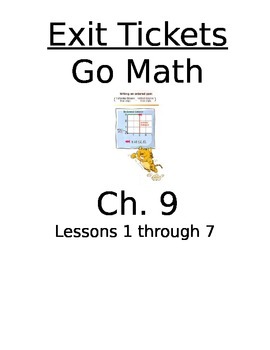Go Math Chapter 9 Exit Slips/Quizzes/Quick Checks
Engaging Minds and Assisting Discovery
87 Followers
Resource Type
Standards
CCSS5.MD.B.2
CCSS5.OA.B.3
CCSS4.G.A.1
CCSS5.G.A.1
CCSS5.G.A.2
Formats Included
- Word Document File
Engaging Minds and Assisting Discovery
87 Followers
What educators are saying
I administer these exit tickets after teaching a lesson to assess who needs additional support from me. These exit tickets are great, just print and use!
Description
Enjoy these exit slips to be used with the 5th grade Go Math Program. Lessons 1 through 7 for Chapter 9 are included. These slips have 2 of the same per page so that you can save paper and copy time! Use as a ticket out of class, a quick check for understanding, a quiz on the lesson, a bell ringer, a pretest, and so much more!
Total Pages
Answer Key
N/A
Teaching Duration
N/A
Report this resource to TPT
Reported resources will be reviewed by our team. Report this resource to let us know if this resource violates TPT’s content guidelines.
Standards
to see state-specific standards (only available in the US).
CCSS5.MD.B.2
Make a line plot to display a data set of measurements in fractions of a unit (1/2, 1/4, 1/8). Use operations on fractions for this grade to solve problems involving information presented in line plots. For example, given different measurements of liquid in identical beakers, find the amount of liquid each beaker would contain if the total amount in all the beakers were redistributed equally.
CCSS5.OA.B.3
Generate two numerical patterns using two given rules. Identify apparent relationships between corresponding terms. Form ordered pairs consisting of corresponding terms from the two patterns, and graph the ordered pairs on a coordinate plane. For example, given the rule “Add 3” and the starting number 0, and given the rule “Add 6” and the starting number 0, generate terms in the resulting sequences, and observe that the terms in one sequence are twice the corresponding terms in the other sequence. Explain informally why this is so.
CCSS4.G.A.1
Draw points, lines, line segments, rays, angles (right, acute, obtuse), and perpendicular and parallel lines. Identify these in two-dimensional figures.
CCSS5.G.A.1
Use a pair of perpendicular number lines, called axes, to define a coordinate system, with the intersection of the lines (the origin) arranged to coincide with the 0 on each line and a given point in the plane located by using an ordered pair of numbers, called its coordinates. Understand that the first number indicates how far to travel from the origin in the direction of one axis, and the second number indicates how far to travel in the direction of the second axis, with the convention that the names of the two axes and the coordinates correspond (e.g., 𝘹-axis and 𝘹-coordinate, 𝘺-axis and 𝘺-coordinate).
CCSS5.G.A.2
Represent real world and mathematical problems by graphing points in the first quadrant of the coordinate plane, and interpret coordinate values of points in the context of the situation.





